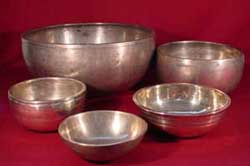Standing bell


Singing bowls, also known as Himalayan Bowls, cup gongs or (in Japan) rin gongs, are a musical instrument and meditation tool dating back many centuries. They were traditionally found in Tibet, Nepal, India, Bhutan, China, Japan, and Korea where they were used by Buddhist monks and lay people. Today they are enjoyed around the world by meditators, health professionals, and anyone who enjoys their beautiful sound. Singing bowls are used in meditation, yoga, healthcare, therapy, music, sound healing and for personal enjoyment.
Antiques singing bowls were made of bronze, often of very fine quality alloy. Fine antiques produce a complex sound. They have a warm pulsing principal tone, clear middle overtones, and shimmering high pitched overtones. These many tones play all at once, producing a unique effect.
New singing bowls are made from industrial quality metal, mainly copper and generally do not produce multiple harmonic overtones. New bowls have a pleasant bell-like tone, but do not have the warm meditative quality of the fine antiques. New singing bowls are exported widely from Nepal and India. They are also made in Japan and Korea but are not widely exported from those countries. In Japan, small singing bowls are commonly found on family shrines.
Many new singing bowls are made to look antique. Many bowls sold as 'antique' are in fact new. Only a few dealers know how to accurately assess antiques. Many dealers call them 'old,' 'vintage,' or 'antique' without really knowing the true age. Genuine antique singing bowls are rare and are available from only a few suppliers.
The bronze in antique singing bowls includes copper, tin and often includes precious metals such as silver and gold. Other metals, including zinc, iron, and nickel may also be present. The mix of several metals is what allows them to produce several harmonic tones at once.
Singing bowls are played by striking with a soft mallet. This produces a warm bell tone. They can also be played by slowly rubbing a wooden mallet around the rim of the bowl to produce a continuous 'singing' sound.
The sound of an antique singing bowl is very relaxing and the calming effects of the instrument are widely researched and explored by medical professionals and therapists. The beneficial effects of the subtle harmonic overtones are immediate and dramatic. New singing bowls and crystal bowls do not produce multiple harmonic overtones and are not able to produce the beneficial effects of the best antique bronze bowls.
Singing bowls can be found in a variety of shapes, sizes, designs and colors. New bowls are often decorated and made with various religious themes and symbols, like the Tibetan mantra om mani padme hum, pictures of the Buddha, mandalas, the eight auspicious signs, etc.
Antique singing bowls never feature such complex ornimentation but often have abstract decoration like lines, rings and circles etched into the surface.
The traditional manufacturing process is now considered a lost art. New bowls never duplicate the beauty of the craftsmanship nor the beauty of the sound. New bowls are made from cheap materials and modern industrial processes. New bowls are often made to look antique and many dealers knowlingly or unknowingly sell new bowls as antiques.
- Information, photos, video, sound clips of antique singing bowls.
- Videos about antique singing bowls.
- Tibetan singing bowls MP3 demo
- In depth information and instructions on Singing Bowls
